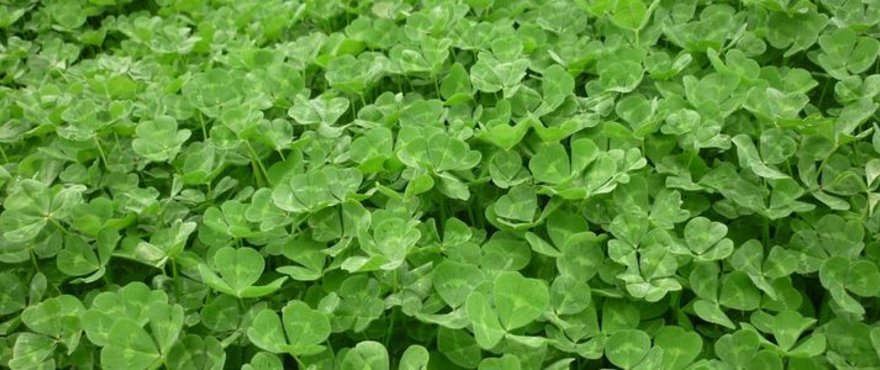Download a copy of the Monti sub clover factsheet.
Monti is an Australian bred yannincum sub clover, bred as an improvement on the popular ‘Trikkala’ cultivar. It has exceptional early season growth with reliable regeneration. Monti will improve the legume content and productivity of pastures in the waterlogged areas.
Monti has a semi-prostrate growth habit. It has been selected for use in permanent or long term phase pastures. Adapted to temperate areas receiving 450–650mm annual rainfall, Monti will perform to its best where intermittent winter waterlogging occurs. Like other yanninicum cultivars, Monti is particularly well adapted to moderately acid soils (pH 4.5–7.0 CaCl2) that range in texture from sandy loams to clays.
Monti has leaf flecking unlike Trikkala. Its flower is predominantly white with slight pink venation. The white coloured seeds are relatively large (approximately 146,000 seeds/kg).
Key features
- Early-mid maturity (110 days), suitable for all areas using Trikkala
- Has better tolerance to phytophthora root rot and clover scorch disease than Trikkala
- Well suited to areas receiving an annual rainfall of 450−650 mm and prone to waterlogging
Key benefits
- More feed for livestock with improved winter growth and total season forage yield than Trikkala
- Improved disease tolerance (compared to Trikkala)
- Produces excellent early winter growth, averaging 46% more than Trikkala
- Excellent adaptation to the shorter growing seasons experienced over the last decade
Performance
Monti has been extensively tested in trials across South Australia and Victoria, demonstrating exceptional early season growth - out-yielding Trikkala, Riverina, Gosse, Napier and Larisa in almost all assessments. In field studies conducted at three sites in South-East South Australia and Western Victoria over 2 years, Monti produced 46% more early winter dry matter than Trikkala (Table 2). Increases in pasture availability at this time of year are particularly valuable.
Being an early-mid maturing Yanninicum cultivar, Monti is well adapted to take advantage of shorter growing seasons whilst still producing high levels of dry matter. The early maturity, good hard seed level, and high seed yields also lead to a more reliable regeneration and persistence over time. Reliable regeneration is also dependent on the amount of soft seed available at the autumn break. Table 3 shows that the soft seed levels of Monti had increased to around 33% by May, similar to those of Trikkala and Gosse. In contrast, Riverina and Napier had the lowest soft seed levels and demonstrated the poorest seedling regeneration.
Disease Resistance/Tolerance
Variety Management/Agronomy
Establishment
Sowing Rate: 8–10kg of Agricote per hectare in a pasture mix or blend.
Seed Bed Preparation: It is recommended to sow following the autumn break into a fine, well prepared seed bed. Seed should be sown with a starter fertilizer and AgriCote coated seed, which includes inoculant, insecticide, fungicide, micro nutrients and bio stimulants to enhance germination can be used.
Weed Control: As Sub clover is sensitive to some post emergent broadleaf weed until established, good pre sowing weed control is vital. Please seek the advice of your local agronomist to ensure satisfactory results.
Sowing: Best results are achieved by direct drilling sub-clover into the top 1–1.5cm into a fine seedbed, press wheels or light rolling will assist establishment in most cases. This should be avoided if the soil is hard setting.
Grazing
Sub-clovers respond well to grazing once established, this is generally when plants will not easily pull from the soil. A good seed set is vital in the first year of a sub-clover pasture to ensure regeneration in the second and subsequent years. To encourage seed set, medium to heavy grazing through late winter/early spring is recommended. Stock numbers should be significantly reduced when the sub-clover starts flowering and until seed set has occurred. Best regeneration will occur the following autumn if the remnant dry growth is removed and good weed control is undertaken. Hay making in the establishment year should be avoided as it will significantly reduce sub-clover seed set and future regeneration.
Plant Breeders Rights (PBR): This variety is registered under Plant Breeders Rights (PBR) in Australia. Unauthorised commercial propagation or any sale, conditioning, export, import or stocking of propagating material is an infringement under the Plant Breeders Rights Act (1994). Any breach of this legislation will leave the grower liable for prosecution.
Disclaimer: The information presented in this brochure is from official and other sources and is considered to be reliable. It is provided in good faith and every care has been taken to ensure its accuracy. Barenbrug does not accept any responsibility for the consequences that may arise from the acceptance of recommendations or the suggestions made.


